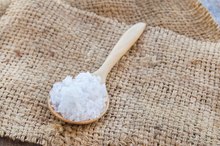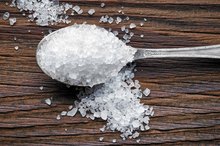What does fact checked mean?
At Healthfully, we strive to deliver objective content that is accurate and up-to-date. Our team periodically reviews articles in order to ensure content quality. The sources cited below consist of evidence from peer-reviewed journals, prominent medical organizations, academic associations, and government data.
The information contained on this site is for informational purposes only, and should not be used as a substitute for the advice of a professional health care provider. Please check with the appropriate physician regarding health questions and concerns. Although we strive to deliver accurate and up-to-date information, no guarantee to that effect is made.
Can Low Salt Intake Improve Bulging Veins on Your Hands?
There are a number of reasons for bulging -- or varicose -- veins on the back of your hands, and despite the cosmetic grievances you may have, these veins are usually harmless. Unfortunately, these veins typically come with age, so nothing can completely prevent them. But sometimes a change in diet can help. A diet lower in sodium could help shrink the size of the veins in your hands, but only if sodium-related swelling was one of the factors contributing to your problem.
What Are Varicose Veins?
Varicose veins are categorized as large bulging veins or smaller, bluish-purple veins that have risen to the surface of your skin. This happens when a vein is damaged. Typically veins only allow blood to pump in one direction, but if the vein is damaged, blood could flow backward, causing your veins to bulge or appear prominently on your skin. This most commonly occurs on legs, but it's not limited to one area. Many people have these veins on their hands, and the appearance usually increases with age.
- Varicose veins are categorized as large bulging veins or smaller, bluish-purple veins that have risen to the surface of your skin.
- Many people have these veins on their hands, and the appearance usually increases with age.
Causes of Varicose Veins
How to Lower Water Weight in Legs & Feet
Learn More
While age is likely the cause of the bulging veins on your hands, a number of things could contribute. Pregnancy, aging, inactivity and swelling are common causes, but an ailment such as a tumor or blood clot could be the cause. Diet can contribute to varicose veins, but it is not the sole cause, just a contributing factor. Ask your doctor about your varicose veins.
- While age is likely the cause of the bulging veins on your hands, a number of things could contribute.
- Diet can contribute to varicose veins, but it is not the sole cause, just a contributing factor.
How Diet Can Affect Varicose Veins
If your diet is high in sodium, it can increase the swelling that leads to varicose veins 1. Sodium is necessary in small doses because it helps regulate the balance of fluids in your body, transmit nerve impulses and aid the contraction and relaxation of muscles. Typically, your kidneys regulate the amount of sodium released into your bloodstream, but if they don't, your body will retain more water. This results in higher blood volume, which puts strain on your veins and causes them to swell.
- If your diet is high in sodium, it can increase the swelling that leads to varicose veins 1.
- Typically, your kidneys regulate the amount of sodium released into your bloodstream, but if they don't, your body will retain more water.
How a Low-Sodium Diet Can Help
What Are the Treatments for Edema in Leg?
Learn More
Sodium might not necessarily be the reason for your bulging veins, but some people are more sensitive to high sodium than others and notice swelling after having too much. The average person should consume 2,300 mg of sodium a day -- 1,500 mg if they're over age 51 or have diabetes, high blood pressure or kidney disease. Foods that contain the most sodium tend to be packaged and processed, but even natural foods can contribute to your overall sodium intake. Read labels if you want a low-sodium diet, and consult a nutritionist if you need help 1.
- Sodium might not necessarily be the reason for your bulging veins, but some people are more sensitive to high sodium than others and notice swelling after having too much.
- The average person should consume 2,300 mg of sodium a day -- 1,500 mg if they're over age 51 or have diabetes, high blood pressure or kidney disease.
Related Articles
References
- Mayo Clinic: Sodium: How to Tame Your Salt Habit Now
- Raetz J, Wilson M, Collins K. Varicose veins: Diagnosis and treatment. Am Fam Physician. 2019;99(11):682-688.
- Critello CD, Pullano SA, Matula TJ, De Franciscis S, Serra R, Fiorillo AS. Recent developments on foaming mechanical and electronic techniques for the management of varicose veins. Expert Rev Med Devices. 2019;16(11):931-940. doi:10.1080/17434440.2019.1682549
- Epstein D, Onida S, Bootun R, Ortega-Ortega M, Davies AH. Cost-effectiveness of current and emerging treatments of varicose veins. Value Health. 2018;21(8):911-920. doi:10.1016/j.jval.2018.01.012
- American Academy of Dermatology. Leg veins: Why they appear and how dermatologists treat them.
Writer Bio
Mariel Loveland is a small business owner with an editorial background in lifestyle and technology. Her work has been featured in Alternative Press, Vice and HelloGiggles. When Mariel's not writing, she can be found swishing her hair on stage with her punk band and managing the ins-and-outs of self-employment.







